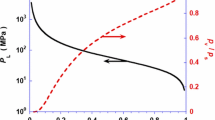Abstract
Early-age cracking may occur in concrete elements if shrink-age is prevented by the surrounding structure. The risk of early-age shrinkage cracking in any given structure is influenced by many factors including the magnitude of shrinkage, rate of shrinkage, degree of stress relaxation, degree of structural restraint, and rate at which material properties develop. In addition to the aforementioned factors, this paper highlights the fact that shrinkage cracking is also influenced by geometry. This paper compares two series of experiments to better understand the role of specimen geometry. In the first series ring specimens of varying size were prepared to undergo the same rate of shrink-age and maximum strain development. Although the maximum residual tensile stress that developed was nearly identical for all geometries, the age at which cracking occurred varied with specimen thickness. In the second series of experiments the combined effect of moisture gradients and specimen geometry was investigated. In these experiments specimen thickness was varied while the surface area exposed to drying was maintained constant. The age of cracking was measured, as was the development of a moisture gradient. Again the influence of specimen size/geometry was apparent with smaller specimens cracking at an earlier age. This paper provides an explanation for this geometry dependence through the use of fracture mechanics concepts.
Résumé
La fissuration peut se produire dans le jeune béton si le retrait est empêché par la structure avoisinante. Le risque de fissuration prématurée due au retrait dans une structure est influencé par de nombreux facteurs tels que l'intensité du retrait, sa vitesse, le degré de relaxation des contraintes, le degré de restriction de la part de la structure, et la rapidité à laquelle se développent les propriétés du matériau. En plus de ces facteurs, cet article met en lumière le fait que la fissuration de retrait est aussi influencée par la géométrie. Deux séries d'expériences sont comparées afin de mieux comprendre le rôle de la géométrie de l'éprouvette. Pour la première série, on a préparé des éprouvettes annulaires de différentes tailles qui ont été soumises au même taux de retrait et de déformation maximale. Bien que la contrainte de tension résiduelle maximale soit à peu près identique pour toutes les géométries, l'âge auquel la fissuration s'est produite varie avec l'épaisseur de l'éprouvette. Dans la seconde série d'essais, on a recherché les effets combinés du gradient d'humidité et de la géométrie de l'éprouvette. Pour ces essais, on a fait varier l'épaisseur de l'éprouvette tout en gardant constante la surface exposée au séchage. L'âge auquel la fissuration se produit a été enregistré, ainsi que l'évolution du gradient d'humidité. À nouveau, l'influence de la taille et de la géométrie est apparue, les éprouvettes les plus petites se fissurant les premières. Dans cet article, une explication de cette dépendance géométrique est apportée par les concepts de mécanique de la rupture.
Similar content being viewed by others
References
Shah, S. P., Weiss, W. J. and Yang, W., ‘Shrinkage cracking-Can it be prevented?’,Concrete International 20 (4) (April 1998) 51–55
Weiss, W. J., Yang, W. and Shah, S. P., ‘Shrinkage cracking of restrained concrete slabs’,J. of Engrg. Mechanics Div., ASCE 124 (7) (1998) 765–774.
Weiss, W. J., Yang, W. and Shah, S. P., ‘Influence of specimen size and geometry on shrinkage cracking’,J. of Engrg. Mechanics Div., ASCE 126 (1) (2000) 93–101.
Weiss, W. J., ‘Prediction of early-age shrinkage cracking in concrete elements’, Ph.D. Dissertation, Northwestern University, Evanston, IL, USA (1999).
Yang, W., Weiss, W. J. and Shah, S. P., ‘Prediction of shrinkage stress and displacement fields in a concrete slab restrained by an elastic subgrade’,J. of Engrg. Mechanics Div., ASCE 126 (1) (2000) 35–42.
RILEM Committee on Fracture Mechanics of Concrete-Test Methods ‘Determination of the Fracture Parameters (KIC and CTODC) of Plain Concrete Using Three-Point Bend Tests’, RILEM Draft Recommendation,Mater. Struct. 23 (138) (1991) 457–460.
Folliard, K. J. and Berke, N. S., ‘Properties of high-performance concrete containing shrinkage-reducing additive’,Cement and Concrete Research 27 (9) (1997) 1357–1364.
Balogh, A., ‘New Admixture Combats Concrete Shrinkage’, Concrete Constructions, (1996).
Bažant, Z. P., ed., ‘Fourth RILEM International Symposium on Creep and Shrinkage of Concrete: Mathematical Modeling’, Northwestern University, August 26–29 1986.
Schießl, A., Weiss, W. J., Shane, J. D., Berke, N. S., Mason, T. O. and Shah, S. P., ‘Assessing the moisture profile of drying concrete using impedance spectroscopy’,Concrete Science and Engineering 2 (2000) 106–116.
Philajavara, S. E., ‘A review of research on drying concrete’,RILEM 27 (June 1965) 61–63.
Müller, H. S., ‘New prediction models for creep and shrinkage of concrete’, ACI SP 135-1 (1992) 1–19.
Author information
Authors and Affiliations
Additional information
Editorial Note Prof. W. Jason Weiss is a RILEM Senior Member. He participates in the work of RILEM TC 181-EAS: ‘Early age shrinkage induced stresses and cracking in cementitious systems’. Prof. Dr. Surendra P. Shah is also a RILEM Senior Member. He works at ACBM Center (Northwestern University), a RILEM Titular Member and participates in RILEM TCs 162-TDF ‘Test and design methods for steel fibre reinforced concrete’ 181-EAS (above-mentioned) ATC ‘Advanced testing of cement-based materials during setting and hardening’ and SOC ‘Experimental determination of the stress-crack opening curve for concrete in tension’. Prof. Shah is a member of the Bureau of RILEM. Surendra Shah is also Editor-in-Chief ofConcrete Science and Engineering, a Scientific journal published quarterly by RILEM Publications S.A.R.L.
Rights and permissions
About this article
Cite this article
Weiss, W.J., Shah, S.P. Restrained shrinkage cracking: the role of shrinkage reducing admixtures and specimen geometry. Mat. Struct. 35, 85–91 (2002). https://doi.org/10.1007/BF02482106
Received:
Accepted:
Issue Date:
DOI: https://doi.org/10.1007/BF02482106




